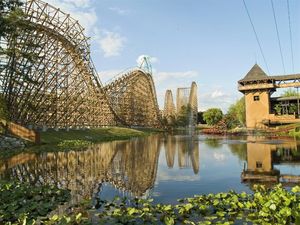Many facilities reach a point where extra storage is no longer optional. New regulations, production changes, or seasonal demand create real deadlines. Waiting months for a massive concrete structure or a fully field-built welded tank often no longer fits the schedule. That is where modular tank installation changes the equation.
Instead of building everything from scratch on site, the core work moves into a factory. The tank becomes a precise kit that arrives ready to assemble, then goes through a streamlined sequence in the field. From the first laser cut panel to final commissioning, each step is designed to save time, reduce risk, and still deliver long service life.
The “Kit” Concept: Precision Manufacturing
Traditional concrete and welded tanks are essentially one-off projects. Crews place forms, weld plates, and apply coatings directly in the weather. Every shift in temperature, humidity, and manpower can affect the outcome.
Modular bolted tanks follow a different path. They are engineered as complete kits and manufactured entirely off-site. The factory work focuses on precision and repeatability.
Typical steps include:
- Laser and CNC cutting
Flat steel sheets are cut to exact dimensions. Bolt holes, panel edges, and openings follow tight tolerances, which speeds up industrial tank assembly later. - Controlled forming
Shell courses, roof panels, and structural members are formed with repeatable bending processes. Parts from different runs still fit together cleanly on site. - Climate-controlled coating
Panels move through cleaning, blasting, and coating lines inside a controlled environment. Stable temperature and humidity help coatings cure properly and reduce human error during this critical phase. - Inspection and kit packing
Coatings are checked for thickness and coverage. Dimensions and bolt patterns are verified. The finished components are labeled, grouped with gaskets and hardware, and packed as a complete kit.
Industry leaders such as Tarsco use this kit concept so every major component arrives on standard trucks, ready to bolt together like an industrial-grade erector set. Because so much work happens under a roof, weather delays have far less influence on quality or schedule.
Foundation: Simpler & Faster Prep
While the tank kit moves through the factory, crews prepare the site. Effective storage tank site preparation still matters, but the demands on the foundation change when the structure is lighter than concrete.
Bolted steel tanks usually weigh significantly less than comparable concrete tanks. That lower weight often allows simpler, faster, and more economical tank foundation types, such as:
- Concrete ring wall
A circular wall under the shell supports many municipal and industrial tanks. It uses less concrete than a full slab. - Full concrete slab
A solid slab provides a rigid base where soils are weaker or loads are higher. - Gravel bands or engineered pads
Certain agricultural silos and lighter tanks can sit on properly designed granular foundations, where codes allow it.
Civil work follows a familiar pattern: grading the site to move water away, placing forms and rebar, setting anchor bolts with templates, and pouring and curing concrete. Because the structure weighs less, the amount of material and excavation can drop, and the work often finishes sooner.
This simpler foundation phase ties directly into a shorter bolted tank construction timeline. The site can be ready by the time the kit arrives, instead of waiting months for heavy civil construction.
The Jacking System: Building from the Top Down
Many people assume tanks go up from the ground with cranes. Modular tank installation often reverses that picture. A tank jacking system allows crews to build from the top down instead of from the bottom up.
A typical sequence looks like this:
- Assemble the roof and top ring at ground level
Crews bolt together the roof structure and the top shell course on temporary supports. Most work happens at comfortable heights. - Set up the jacks
Hydraulic or mechanical jacks attach to the tank perimeter. Controls and safety locks are checked. - Lift the assembly
The system raises the roof and top ring a short distance in a controlled, even motion. - Install the next ring underneath
Workers bolt the next shell course in place below the raised section, still working near ground level. - Repeat the cycle
Lift again, add another ring, tighten, inspect. The shell grows downward until it reaches full height.
This top-down method brings clear speed and safety benefits:
- Crews spend more time working near the ground instead of high scaffolding;
- Reliance on large cranes decreases, so wind and crane scheduling pose less risk;
- The repeating cycle gives the project a steady rhythm that fits well with a planned tank jacking system approach.
Together, these factors make the field phase more predictable and help keep the overall schedule on track.
Sealing the Deal: Gaskets and Hardware
Because bolted tanks rely on many joints, leak concerns are natural. Modern designs manage that risk with high-tech sealants, engineered joints, and carefully chosen hardware.
Key elements include:
- Mastic or EPDM gaskets between panels
Before the two panels come together, installers apply mastic sealant or place EPDM gaskets along the lap. When bolts are tightened to the specified torque, these materials compress and fill micro-gaps between steel surfaces. - Engineered bolt patterns and torque procedures
Bolt spacing and layout are designed to distribute loads and gasket pressure evenly. Crews follow defined torque sequences to keep compression uniform along each seam. - Corrosion-resistant hardware
Bolts, nuts, and washers use coatings or stainless alloys suited to the stored product and environment. - Encapsulation caps for bolt heads
Caps cover exposed bolt heads so rain, chemicals, and UV do not attack these points. This extra protection helps maintain a leak-free joint over the long term.
These details work together to keep factory-coated steel tanks tight even under demanding operating conditions. With proper assembly and inspection, the joints match the performance expectations of industrial and municipal storage applications.
Final Commissioning: Ready in Weeks, Not Months
Once mechanical work ends, the project moves into final checks and commissioning. This stage turns a completed structure into a working storage asset.
Typical tasks include:
- inspecting coatings, hardware, and penetrations;
- confirming ladders, platforms, and safety equipment;
- verifying torque on critical connections;
- performing hydrostatic or other leak tests;
- checking vents, nozzles, and instrumentation.
The advantage of modular tank installation becomes obvious when you compare field durations. A typical scenario looks like this:
| Tank type | Typical field erection time* |
| Modular bolted steel tank | About 1–2 weeks |
| Welded steel tank | Roughly 1–2 months or longer |
| Concrete tank | Often several months in total |
*Actual timing depends on size, site access, climate, and local requirements.
Because manufacturing, storage tank site preparation, and field assembly can overlap, owners often achieve rapid liquid storage deployment. The tank moves from “factory” to “field” to “in service” in a much shorter window than traditional builds.
That “Field to Function” path matters. The sooner a tank passes its tests and connects to process or distribution systems, the sooner it starts supporting operations and delivering a return on investment. For many projects, that compressed timeline is just as important as the structure itself.






